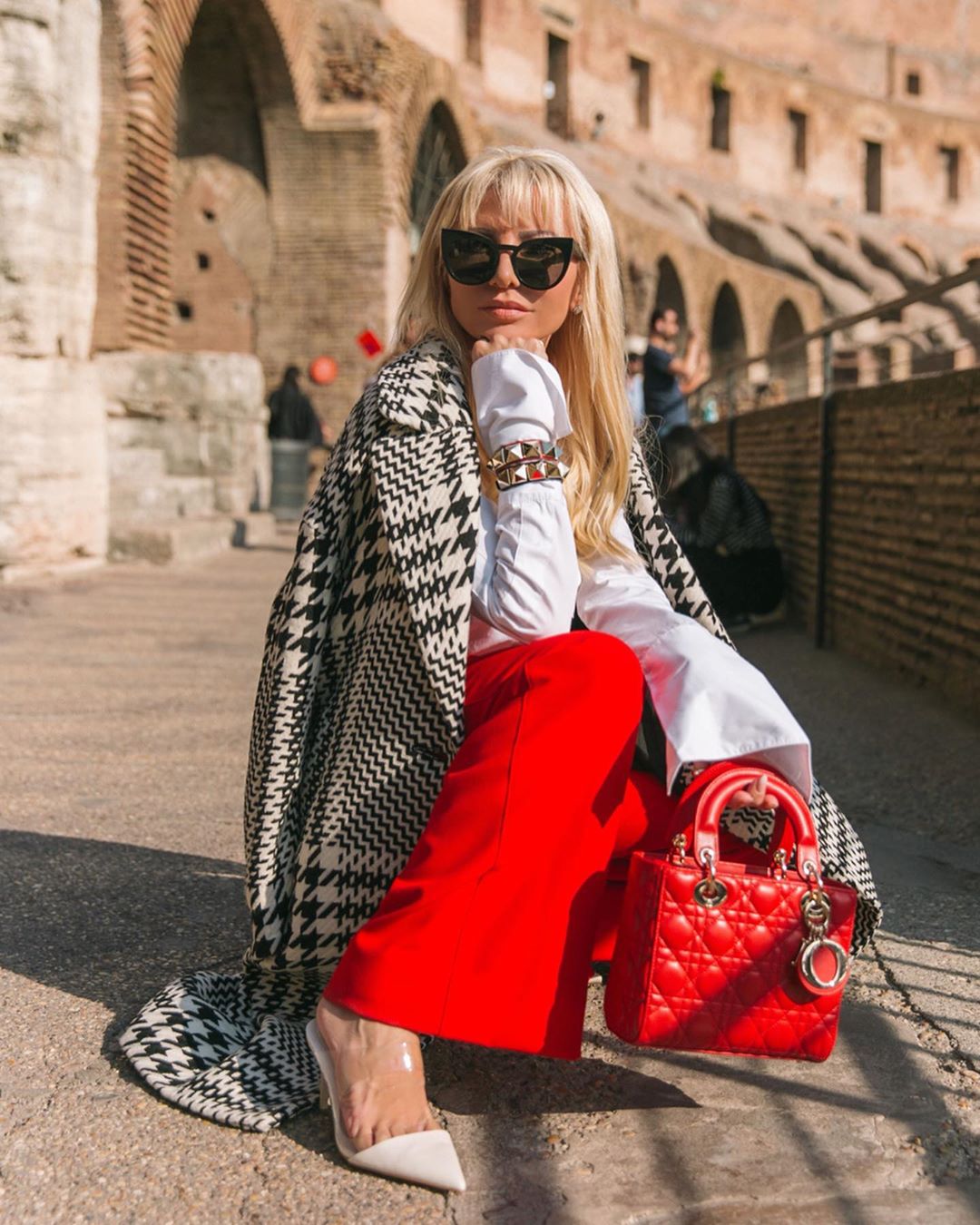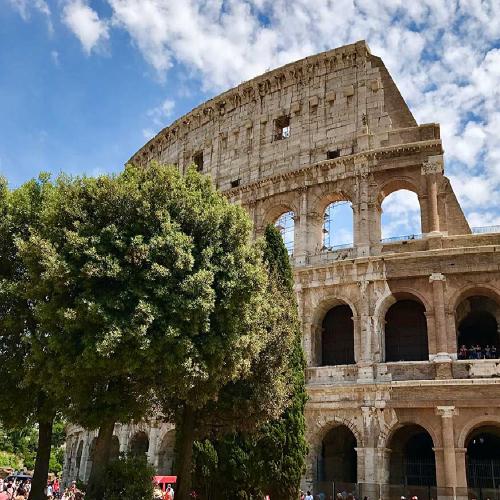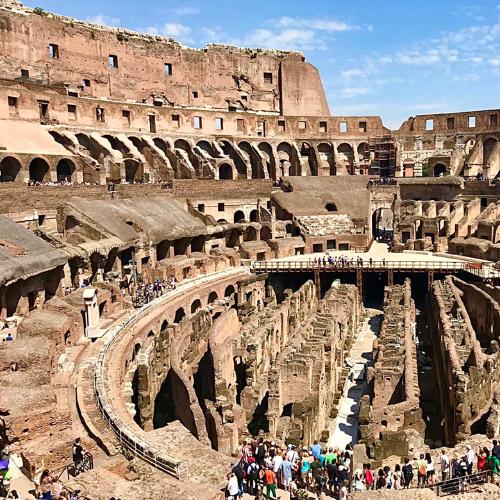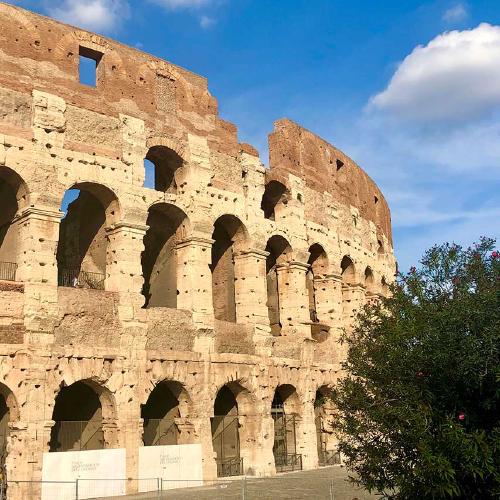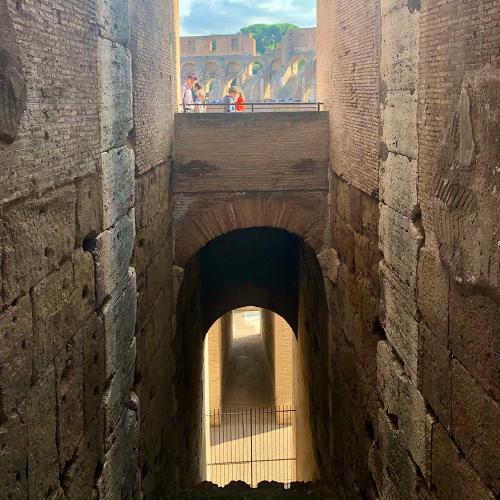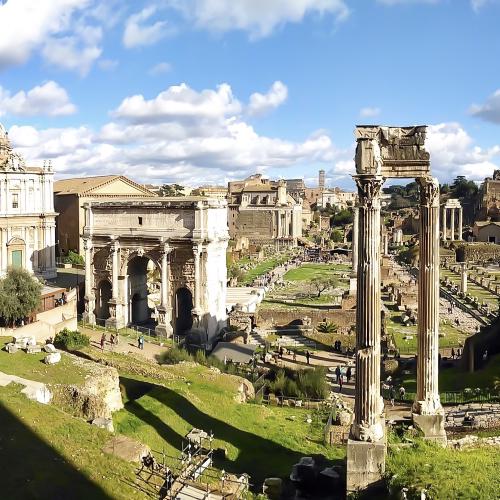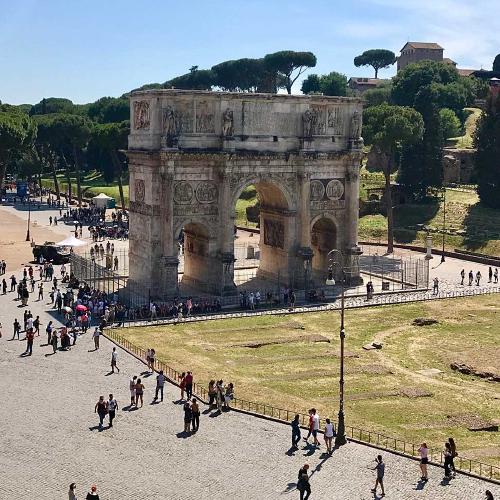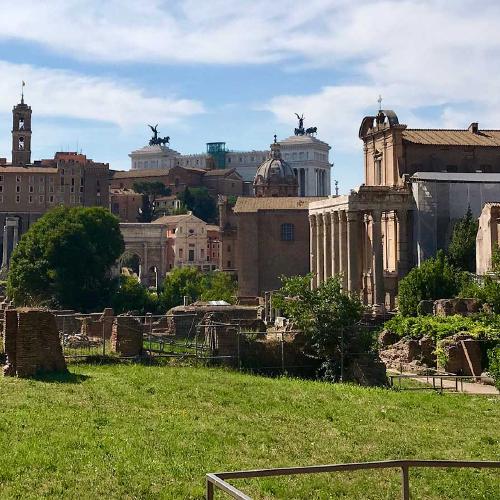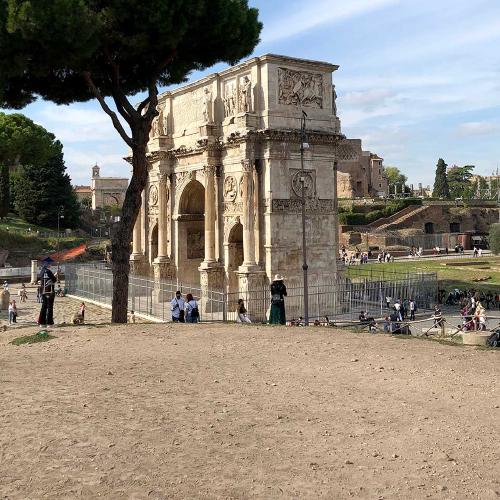My journey starts with the Colosseum. The Colosseum is an amphitheater that could hold an estimated of 50,000 to 80,000 spectators during phases of its various renovations over the centuries, having an average audience of about 65,000. It was used for gladiatorial contests and public spectacles such as mock sea battles (for only a short time as the hypogeum was soon filled in with mechanisms to support the other activities), animal hunts, executions, re-enactments of famous battles, and dramas based on Classical mythology. The building ceased to be used for entertainment in the early medieval era. It was later reused for such purposes as housing, workshops, quarters for a religious order, a fortress, a quarry, and a Christian shrine. Although substantially ruined because of earthquakes, thieves, and stone-robbers, the Colosseum is still an iconic symbol of Imperial Rome and is listed as one of the New7Wonders of the World.
This place always makes me feel a bit strange. It’s breathtaking from an architectural point of view, but if you think of how many souls, humans and animals were lost here, it makes me feel a bit sad.
Next to the Colosseum is the Roman Forum. As planned, our journey continued towards the forum, but the lines were too long so we had to abort. So be prepared!
Nevertheless this place is a sight for sore eyes. I visited it on my last trip and it is definitely something you don’t want to miss.
For centuries the Forum was the center of day-to-day life in Rome: the site of triumphal processions and elections; the venue for public speeches, criminal trials, and gladiatorial matches; and the nucleus of commercial affairs. Here statues and monuments commemorated the city’s great men. The teeming heart of ancient Rome, it has been called the most celebrated meeting place in the world, and in all history. Located in the small valley between the Palatine and Capitoline Hills, the Forum today is a sprawling ruin of architectural fragments and intermittent archaeological excavations attracting 4.5 million or more sightseers yearly.
My next destination is the Vittorio Emanuele II monument. It’s a walking distance of 3-5’ from the Roman Forum. So no need to take any transportation to get there. It is next to the Piazzi Venezia square. It is a remarkable white monument honouring Italy’s first king Vittorio Emanuele II. Italians also call the Monument of Victor Emanuel II ‘Il Vittoriano’ and ‘Altara della Patria’, or altar of the fatherland. The monument commemorates the unification of Italy in 1861 and the first king of Italy, Victor Emmanuel II. Although this monument was built in his honour, he is not buried there. Instead, he is buried in the Pantheon. The impressive building was built between 1895 and 1911 on top of Palatine Hill and was designed by Giuseppe Sacconi. The Altare della Patria contains a lot of white marble from the region of Brescia. Because of how large it is (135 metres wide and 70 metres high) the building was also given several nicknames, ranging from the wedding cake, the dentures, to the typewriter ;)
Next day we’ve decided to visit the Pantheon. The Roman Pantheon is the most preserved and influential building of Ancient Rome . It is a Roman temple dedicated to all the gods of pagan Rome. As the brick stamps on the side of the building reveal it was built and dedicated between A.D 118 and 125.
A bit of history. The emperor Hadrian (A.D 117-138) built the Pantheon to replace Augustus’ friend and Commander Marcus Agrippa’s Pantheon of 27 B.C. which burnt to the ground in 80 A.D.
When approaching the front of the Pantheon one can see the inscription above that still reads in Latin the original dedication by Marcus Agrippa. The inscription reads :“M.AGRIPPA.L.F.COSTERTIUM.FECIT” Marcus Agrippa son of Lucius, having been consul three times, made it. Despite all the marvelous building projects that the emperor Hadrian produced during his reign, he never inscribed his name to any, but one, the temple of his father Trajan. That is why the Roman Pantheon bears the inscription of Marcus Agrippa, and not the emperor Hadrian. The pediment, (the triangle section above the inscription) is blank today, but there would have been sculpture that acted out the battle of the Titans. Great bronze doors guard the entrance to the cella and would have been covered in gold, but it has disappeared under unknown circumstances.
The original use of the Pantheon is somewhat unknown, except that is was classified as a temple. However, it is unknown as to how the people worshipped in this building, because the structure of the temple is so different from other traditional Roman temples such as in the Roman Forum. The Pantheon exists today in such amazing form because the Byzantine emperor Phocas gave it to Pope Boniface the IV in A.D 608 and it was used as a church ever since. The Pantheon has been in use since the time it was built.
Next stop is the Sant’Angelo Bridge. It’s a such beautiful bridge with the river Tiber running underneath it. Here you can watch street artists performing or walk along small open markets, where you can find souvenirs, books or buy beautiful sketches of Rome.
In Italian it is called Ponte Sant’Angelo, and it’s probably the finest surviving bridge in Rome itself, built over the Tiber by the emperor Hadrian (reigned 117–138 AD) to connect the Campus Martius, with his mausoleum (later renamed Castel Sant’Angelo). The bridge was completed about AD 135. It consists of seven stone arches and five main spans of about 60 feet (18 m) each, supported on piers 24 feet (7 m) high. The name of this beautiful bridge is explained by a legend, that an angel appeared on the roof of the castle to announce the end of the plague that Rome was suffering from back then. Ten strikingly beautiful angel sculptures, designed by famous sculptor Gian Lorenzo Bernini, line the spectacular travertine marble made bridge. Each sculptured angel symbolizes a part from the story of Jesus Christ’s suffering and death by crucifixion. Statues of the saints Peter and Paul watch over the entrance way of the bridge. One word. Beautiful!
One super popular must see place are the Spanish steps. With its irregular butterfly design, the beautiful “Scalina Spagna” in Italian, is just one of these must see places when in Rome and a great example of Roman Baroque Style. It’s a great place to enjoy the atmosphere and views of the Eternal City. You used to be able to sit on them, but now there is a law that prohibits you of doing that. So don’t do the mistake of sitting even for a second, because police will come with a rather unpleasant way, to tell you to stand up! I did manage to sit though to take a shot, before I was whistled to stand up! Naughty, right? Lol
More information about the steps, is that it’s a wide irregular gathering place consisted of 138 steps placed in a mix of curves, straight flights, vistas and terraces. They connect the lower Piazza di Spagna with the upper piazza Trinita dei Monti, with its beautiful twin tower church dominating the skyline. The Spanish steps unique design and elegance has made it a popular place for artists, painters and poets who were attracted to the place which inspired them in return. The artists’ presence attracted many beautiful women to the area, hoping to be taken as models. This in turn, attracted rich Romans and travelers. After a short time, the steps were crowded with people of all kinds of backgrounds. This tradition, of the Spanish Steps as a meeting place, has lived on ever since! Too bad you can’t sit anymore ..
Villa Borghese is a place you definitely have to visit, in beautiful Rome. I’ve never been there before and I was surprised by how big it actually is! Its landscape gardens (which reminded me of Versailles) , containing a number of buildings, museums and attractions. It is the third largest public park in Rome (80 hectares or 197.7 acres) It contains a beautiful big lake, where you can rent a small boat and do a romantic paddle ride. The Villa’s gardens were private, but were bought by the commune of Rome and given to the public in 1903. The large landscape park contains several villas. The Spanish Steps lead up to this park, and there is another entrance at the Porte del Popolo by Piazza del Popolo. At the center of the villa, there are golf cars that you can rent with or without a driver, in order to explore the many acres of this land. I strongly recommend to get the car with a driver, because he knows the way around there and he can drive you to see the most beautiful part of it! The Pincio (the Pincial Hill of ancient Rome), in the south part of the park, offers one of the greatest views over Rome. Its panoramic views are just breathtaking!!
My all time favorite monument is definitely the Fontana Di Trevi. As an architect, I’m just ‘wowed’ by its architectural beauty! The Trevi Fountain (in English) is a fountain in the Trevi district, designed by Italian architect Nicola Salvi and completed by Giuseppe Pannini and several others. Standing 26.3 metres high and 49.15 metres wide, it is the largest Baroque fountain in the city and considered the most famous fountain in the world. Historically this fountain was strategically places at the junction of three roads (tre vie) marking the terminal point of the “modern” Acqua Vergine, the revived Aqua Virgo, one of the aqueducts that supplied water to ancient Rome. In 19 BC, supposedly with the help of a virgin, Roman technicians located a source of pure water some 13 km from the city. This scene is presented on the present fountain’s façade.
However, the eventual indirect route of the aqueduct made its length some 22 km. This Aqua Virgo led the water into the Baths of Agrippa. It served Rome for more than 400 years. Fontana Di Trevi is the place I always visit when I come to Rome. It is well know for tossing a coin and making a wish.
On my last trip here, I discovered a small restaurant (in Italian are called trattorias) called ‘Pizza in Trevi’, which has amazing pizzas. My absolute favorite is pizza carbonara!! (address below at Useful Tips)
Piazza Navona, is one of the largest and most beautiful piazza/squares in Rome with three impressive fountains, including la Fontana dei Quattro Fiumi, with its large obelisk at the centre. The baroque church of Sant’Agnese in Agone, provides an impressive backdrop. The shots you can take here are just breathtaking!! Piazza Navona (pronounced (piatsa na’vona) was a public space. It is built on the site of the Stadium of Domitian, built in the 1st century AD, and follows the form of the open space of the stadium. The ancient Romans went here to watch the agones (games), and hence it was known as “Circus Agonalis” (competition arena). It is believed that over time the name changed to “avoneto navone” and eventually to “navona”.
Surrounding the square are restaurants where you can eat (pizza! what else ;)) and watch street artists, painters and musicians who add a lively atmosphere to the scene. Simply Bellisima!!
One of the most bohemian neighborhoods of Rome is Trastevere. Trastevere is one of the most colorful areas and is often referred to as a “real Roman neighborhood.” Its name means “across the river” and refers to its location on the west bank of the Tiber or Tevere in Italian. It was once an “insiders” neighborhood favored by working-class Romans and travelers who wanted to avoid the crowds and soak up some real local atmosphere. Well, the word is out and Trastevere is no longer an undiscovered part of Rome! And although rents may have gone up, within its maze of narrow streets and centuries-old piazzas, you can still get a taste of authentic Rome, and make your own discoveries in hidden churches, Bijoux shops, small museums and lively bars and restaurants.
My only regret is that, I didn’t get the chance to revisit the Vatican, which I have been to twice and I always feel overwhelmed there. But it’s an absolutely incredible experience you surely can’t miss!!
Some history details about it, is a must!
Vatican City, officially Vatican City State (in italian Stato della Città del Vaticano) is an independent city - state enclaved within Rome. Established with the Lateran Treaty (1929), it is distinct from, yet under “full ownership, exclusive dominion, and sovereign authority and jurisdiction” of the Holy See. The Holy See dates back to early Christianity, and is the primate episcopal see of the Catholic Church, with 1.3 billion Catholic Christians around the world distributed in the Latin Church and 23 Eastern Catholic Churches. The independent Vatican City-state, on the other hand, came into existence on 11 February 1929 by the Lateran Treaty between the Holy See and Italy, which spoke of it as a new creation, not as a vestige of the much larger Papal States (756–1870), which had previously encompassed much of central Italy. Within the Vatican City are religious and cultural sites such as St. Peter’s Basilica, the Sistine Chapel and the Vatican Museums. They feature some of the world’s most famous paintings and sculptures. The unique economy of Vatican City is supported financially by the sale of postage stamps and souvenirs, fees for admission to museums, and sales of publications. With an area of 44 hectares (110 acres), and a population of about 1,000, it is the smallest sovereign state in the world by both area and population.
Video highlights
Helpful Tips
Restaurants
PIZZA DI TREVI - Via San Vincenzo, 30/30a - Roma (favorite pizza)
SETTIMIO ALL’ARANCIO - Via dell’Arancio 50 | 00186 - Roma
L’ AMATRICIANELLA - Via del Leone, 4 (favorite pasta)
ZUMA (one of the best Japanese restaurant in the world) - Palazzo Fendi, Largo Coldoni, 420
Ice cream
VERDE PISTACCHIO (my favorite) - via Nazionale 239
CIAMPINI - P.zza S. Lorenzo in Lucina, 29
Shopping
(The best street for designer stores is Via Condotti. Heaven ;))
RINASCENTE Department store (Roma Tritone) - Via del Tritone, 61
Best designers boutiques (personally visited and loved, for the store and/or service)
DIOR - Via dei Condotti, 1-4
GUCCI - Via dei Condotti, 8
VALENTINO - Via Piazza Di Spagna, 38
FENDI (lower ground of FENDI Building) - Palazzo Fendi at Largo Carlo Goldoni, 420
LOUIS VUITTON (new store contains the oldest Roman Cinema theater) - Via dei Condotti, 13
BOTTEGA VENETA - Piazza di S. Lorenzo in Lucina, 9
